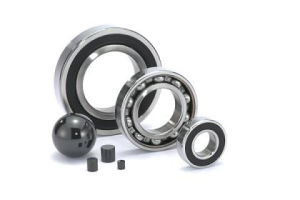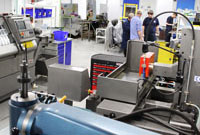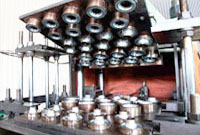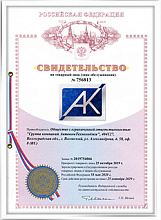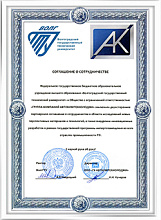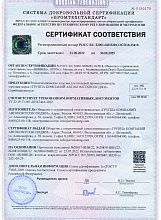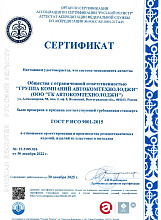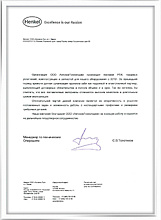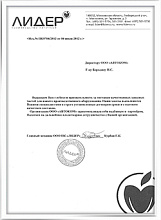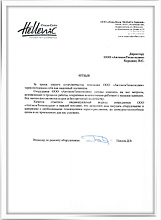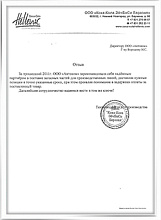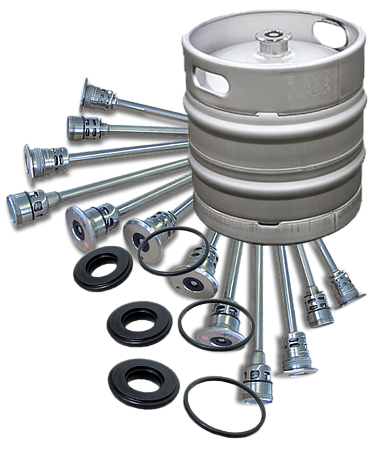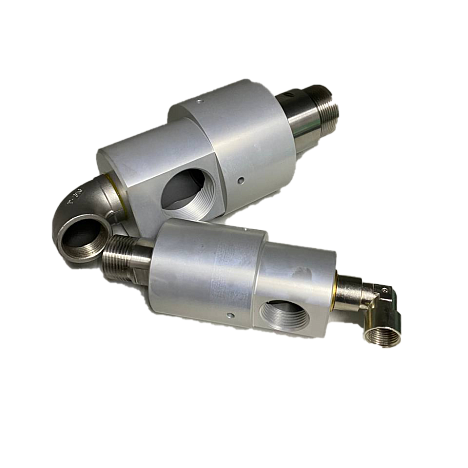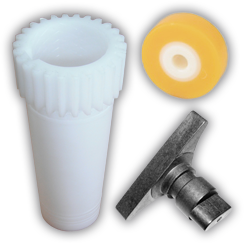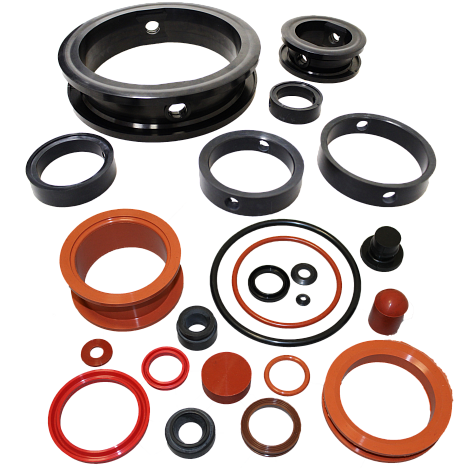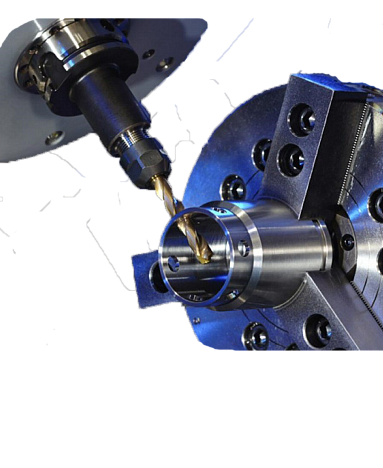
At the end of the XIX, beginning of the XX century, the supply of water or steam in a rotating cylinder was carried out with the help of stuffing box packing or gland packing, this method of sealing was very inefficient. The more the sealing material was worn, the more leakage.
In August 1933, R.O. Monroe and L.D. Hoff, based on a local mill, designed and built their first rotary joint. It was a device that eliminated the problems associated with the use of stuffing box packing and stuffing box, it allowed the introduction of water or steam into the rotating cylinder in a more economical way. To prevent dispersion of liquid or gaseous media, a spring-loaded mechanical seal was used. The secret of the success of the rotary joint was the end seal, it allowed the parts of the rotary joint to rotate with the machine, while ensuring the tightness of the liquid supplied to the cylinder.
In the late 1930s, early 1940s, the supply of liquid or gas to a rotating cylinder was carried out mainly by means of a rotary coupling. However, there were some problems associated with the installation of rotary connections. After the Second World War, the design of the rotary joint was perfected. To do this, a flexible metal hose was used that allowed the rotary joint to exhibit some flexibility in motion as the seal wears. By 1946, in the original design, a few more improvements had been made and the size of the rotary joints had been increased to meet the needs of the various industries in which they were applied.
In 1954, serious changes were made to the design of the rotary joint. They were aimed at reducing the physical size of the device and its compliance with specific areas of application. By 1957, many industrial enterprises were concerned about increased productivity, as well as the problem of heating and cooling rotating cylinders. At this time, the company Kadant Johnson, has launched a program to investigate the effectiveness and application of various types of bleeding liquids (siphoning devices), both in rotating equipment and in a stationary one. The effectiveness of siphon clearances was also studied under the general heat transfer from the cylinders to the body.
In 1959, Kadant Johnson modernized a paper dryer in Pensacola (Florida, USA) to test and conduct actual tests of its rotating connections and various siphoning devices. In 1962, a research center was established in the city of "Three Rivers" (Michigan, USA), and in 1963 the first photographs of the inner part of the operating dryer were obtained. Personnel involved in the design and operation of devices used to rotate the cylinders, thanks to these photographs, received valuable information on the rate of condensation of steam and the processes occurring in the dryer. On the basis of these studies, the technology of rotational connection and technology of siphoning were identified in selected areas of industry.
In the late 1950s, early 1960s, this group of researchers continued to develop new projects and accumulate knowledge to meet the needs of all sectors. The need for higher operating temperatures and speeds required changes in the design of rotary connections. Details were developed such as quick-release nipples, pressure compensators, increased dimensions and service life.
In the late 1960s and early 1970s, new sealing materials were tested, such as plastic, teflon and ceramics.
Despite the fact that the first rotary joints were created only to seal the working steam or liquid medium, today there are thousands of configurations of standard and adjustable rotary joints, self-supported or supported from the outside, one- or two-way, using water, air, coolant , oil, molten salt and gas, used at very low temperatures, and higher than 1000°F (538°C); and also with a speed of rotation up to 50,000 rpm.
The main manufacturers of rotary joints.
Kroma Ltd.
The company «Kroma Ltd», was founded in 1994 as a private enterprise for the production and trade of sealing devices. The company's focus has always been on developing and manufacturing sealing systems for rotating equipment such as pumps, compressors and mixers. The technological process of production is completely carried out "inside" the company. Starting with the development of new products, production and testing, as well as monitoring and monitoring the operation of end-users..
Our clients turn to them from various industries, such as:
- pulp and paper industry;
- oil and gas industry;
- power plants and energy sector;
- food industry;
- water treatment industry.
The company «Kroma Ltd» is certified according to the ISO 9001 standard, and also has the ATEX certificate for its products. Thanks to constant investments in its employees and their knowledge and skills, as well as the application of new technologies and materials, «Kroma Ltd» constantly improves the quality of its products and achieves sustainable growth.
ROTOFLUX.
The company «ROTOFLUX», was founded more than 20 years ago. It develops and manufactures a wide range of rotary joints for various applications. The headquarters of «ROTOFLUX» is located in Trezzano sul Naviglio (Italy), and its branches in Germany and China. The company also has an extensive network of authorized dealer centers around the world.
Kadant Inc (Kadant Johnson Europe B.V. - Kadant Johnson и Johnson Fluiten).
For more than a century, «Kadant Inc» has provided intelligent and efficient solutions for the processing industries. Its products are used in fiber processing, liquid processing, cleaning and filtration, as well as in woodworking systems. «Kadant Inc» designs and manufactures products used in various industries.
The company is a supplier of components and engineering systems used in manufacturing industries around the world. Although «Kadant Inc» is a relatively new brand and in 2001 became a completely independent public company, many of their enterprises have served industrial customers for more than 100 years. The main product brands sold under the Kadant trademark through subsidiaries include well-known industry names such as AES, Black Clawson, Carmanah, Goslin, Johnson, Lamort, Lodding, Noss, PAAL and Vickerys.
«Kadant Inc» is based in Westford (Massachusetts, USA) with a staff of 2,400 employees in 20 countries around the world.
The products and services of the «Kadant Inc» brand are sold to the industry around the world through subsidiaries located in North America, South America, Europe and Asia.
Duff-Norton.
Since 1883, «Duff-Norton» has earned a reputation for reliable and high-quality products that meet the needs of customers in transportation, positioning and pumping. Both standard and specially designed devices (structures) are subjected to thorough testing throughout the design process to ensure maximum performance and quality.
The company «Duff-Norton» has been registered since 1994 according to ISO 9001, constantly studying and implementing new designs. Together with the subsidiary companies CM Engineered Products GmbH (Pfaff-silberblau and Alltec Antriebstechnik brands) and «Duff-Norton Europe» is the largest manufacturer for medium-sized (mobile) devices in the world, providing solutions for both pumping devices and integrated technological solutions.
Christian Meier GmbH & Co. KG.
«Christian Meier GmbH & Co. KG» was founded in 1925 and is located in the city of Heidenheim (Germany). The company is engaged in designing, developing, manufacturing and studying the market of rotary joints for machine tools, textile, plastic, paper, rubber, food, metallurgical and chemical industries. «Christian Meier GmbH & Co. KG» offers rotary joints that are used as components for connecting stationary pipes to rotating cylinders and rotors, for transferring pressurized media, heating or cooling the system and supplying the medium until processing. Their products are used in machine tools, calender for plastics, rubber and non-woven materials, printed, flexographic, textile, leather, paper making machines and other industries. The company offers its products through a network of distributors, as well as via the Internet.
Deublin.
The company «Deublin» was founded in 1945 by Luke Dembler and Dick Lynn. The name of the company is a combination of two names.
Presented in its time on the market rotational connection by the company «Deublin», was a unique solution that included a balanced mechanical seal.
At that time, the most popular type of seal used in the industry were closed seals, which were based on maintaining the pressure in the system when the sealing surfaces came into contact.
Increased speed of various equipment, including printing presses, led to rapid wear of closed seals.
Luke Dembler, developed a mechanical seal for rotary connection. Its development, was immediately approved by the industry, with this began the development of the company «Deublin».
Today, «Deublin» consists of 14 subsidiaries. In addition to the main branches located in Germany, England and Japan, «Deublin» also manages subsidiaries in Italy, Finland, France, Spain, Mexico, Singapore, Brazil, China, Austria and Poland. In addition, «Deublin» has a sales office in Canada and Sweden.
In 2004, «Deublin» created «Deublin Steam Systems» in Buford, Georgia, USA. Thanks to this company, «Deublin» now offers comprehensive services to optimize steam systems and optimize drying machines.
 en
en
 Русский [ru]
Русский [ru]

